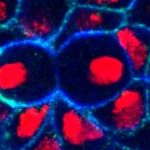Link to Pubmed [PMID] – 33999996
Link to DOI – dev19730110.1242/dev.197301
Development 2021 05; 148(10):
Movement of epithelial cells in a tissue occurs through neighbor exchange and drives tissue shape changes. It requires intercellular junction remodeling, a process typically powered by the contractile actomyosin cytoskeleton. This has been investigated mainly in homogeneous epithelia, where intercalation takes minutes. However, in some tissues, intercalation involves different cell types and can take hours. Whether slow and fast intercalation share the same mechanisms remains to be examined. To address this issue, we used the fly eye, where the cone cells exchange neighbors over ∼10 h to shape the lens. We uncovered three pathways regulating this slow mode of cell intercalation. First, we found a limited requirement for MyosinII. In this case, mathematical modeling predicts an adhesion-dominant intercalation mechanism. Genetic experiments support this prediction, revealing a role for adhesion through the Nephrin proteins Roughest and Hibris. Second, we found that cone cell intercalation is regulated by the Notch pathway. Third, we show that endocytosis is required for membrane removal and Notch activation. Taken together, our work indicates that adhesion, endocytosis and Notch can direct slow cell intercalation during tissue morphogenesis.

